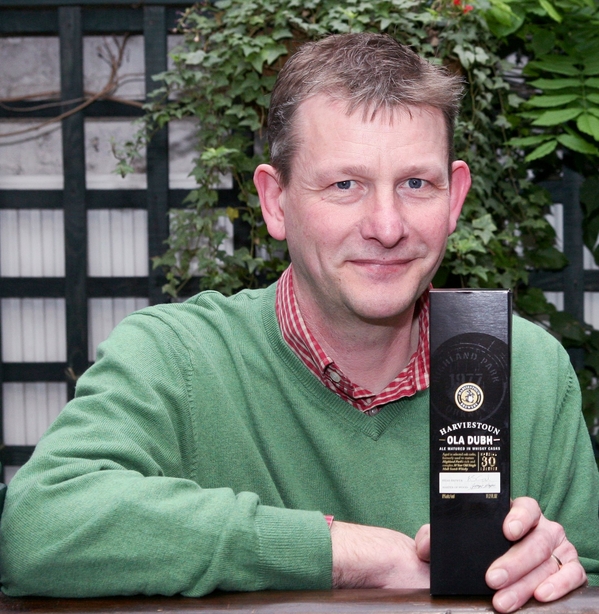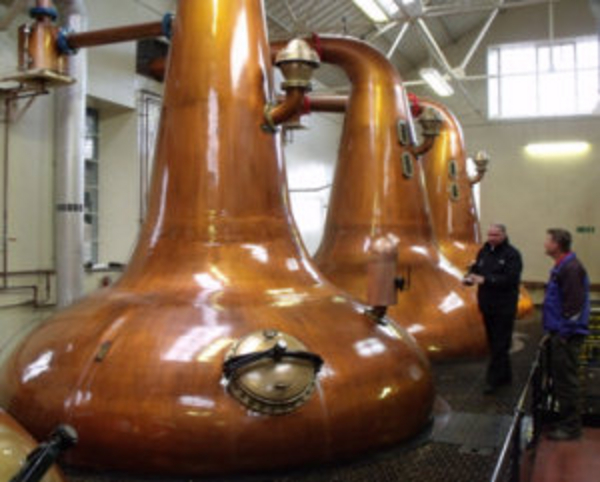Whisky and beer: Highlands harmony
Added: Saturday, January 4th 2014

The marriage of ale and whisky is a log and happy one in Scotland. Harviestoun of Alva has brewed and matured three beers called Ola Dubh – Black Oil in English. The beer is aged in oak casks provided by the Highland Park malt whisky distillery on Orkney. To underscore the whisky connection, the versions of Ola Dubh are labelled Special Reserve 12 year-old, 16 year-old and 30 year-old depending on the age of the casks and the malt whiskies they held.
Ola Dubh is based on Harviestoun's successful cask and bottled beer, Old Engine Oil, which has won the prestigious Tesco Beer Challenge. Head brewer Stuart Cail (above) describes Old Engine Oil as a beer with a lot of residual sweetness but balanced by good bittering hops: English East Kent Goldings and Fuggles, and American Galena. The richness of the palate is developed with the addition of roast barley and oats alongside pale malt. The oats, Stuart says, gives luscious smoothness to the beer. Old Engine Oil is 6% with 30-35 units of bitterness (IBUs). The version brewed as Ola Dubh is 8%, has greater amounts of roast barley and oats, and has 40-50 IBUs: the beer needs both the strength, depth of flavour and bitterness to counter the impact of whisky character locked in the oak of the casks.
Highland Park sent 60 or 70 casks, both 54-gallon hogsheads and 108-gallon butts, to Harviestoun. In sharp distinction to Innis & Gunn, which uses American Bourbon casks, the Highland Park casks are all sourced from Spanish sherry makers in the Jerez area. It was a major operation transporting large wooden casks by sea and road from Orkney to Alva.
Highland Park
Highland Park is the world's most northerly distillery (copper stills pictured below). It dates from 1798 and is an acclaimed producer of single malt whiskies. When American drinks writer F. Paul Pacult published a list of the top 110 spirits in the world, Highland Park 18-year old was top of the list. Further glory came in 2007, when Highland Park was named Distiller of the Year in the San Francisco International Spirits Competition.
Jason Craig, Global Controller at Highland Park, says: “Our whisky is made with the same enduring belief and integrity, to the same exacting standards, as it has been since 1798. That's why it is the most respected single malt whisky in the world. Like Harviestoun, we are passionate about tradition and obsessed by quality.”
The rare flavours of Highland Park whiskies are made possible by the climate and geography of Orkney. The island has no trees. Peat, with heather roots, is dug from the banks of the Hobbister Hill to provide fuel for the distillery, where floor-malted Optic barley is cured over peat fires. The peat burns slowly and gives a less smoky finish to the whisky than the famous peated brands of Islay. Orkney also enjoys the advantages of the Gulf Stream, which can make the island surprisingly warm and means there are fewer temperature variations than in other parts of Scotland (not that Orcadians consider themselves Scottish). There is also less evaporation – the famous “angels' share – during maturation.
All the casks at Highland Park come from Spain, even those made of American oak. “We don't use Bourbon casks,” Jason Craig says. “All our casks have been filled with sherry from Jerez for three years. They are 10 times more expensive that Bourbon casks.” Jason didn't think that maturing beer in whisky casks would work: “I thought the beer would disintegrate.” He is naturally delighted with the results at Harviestoun.

Beer and wood
For centuries, wine, spirit and beer were stored in wooden vessels. Oak has always been the preferred wood as a result of its strength. In England, local oak was used until stocks became low as a result of the demand for wooden ships of war. In its place, Memel oak from Poland and other Baltic states was imported. Oak casks were unlined: one of the constituent beers of the early blended porters and stouts of the 18th century was known as “stale” as a result of picking up woody and tannic flavours from the casks and also from bacteria trapped in the wood. With the development of modern lager beers in the 19th century, with their more delicate flavours, brewers began to line both wooden fermentation vessels and storage casks with wax, enamel or pitch. In England, Marston's continues to ferment Pedigree Bitter in oak “union” casks, while three brewers, Samuel Smith, Theakston's and Wadworth, still deliver beer to pubs in unlined wooden casks. Greene King's Strong Suffolk Ale is a blend of two beers, one of which is stored for between one and three years in wooden tuns. In Belgium, gueuze and lambic beers made by spontaneous fermentation are stored in unlined wooden vessels, usually bought from Port manufacturers in Portugal. The “sour red beers” of Flanders, notably Rodenbach, are also matured in wooden vessels. Memel oak remains the preferred variety of wood and, until the arrival of Innis & Gunn's oak-aged beer matured in Bourbon casks, there was great opposition to the use of American oak as a result of the powerful wood flavours it gives to beer.
Ola Dubh: the tasting
Stuart Cail is at pains to stress that the beers are never blended and there will be variations from one batch to another. The notes that follow are based on a tasting organised in London by Harviestoun and Highland Park. The beers are all 8% alcohol by volume.
Special Reserve 12-year old: oak, toffee, caramel and smoky notes on the nose with sweet malt in the mouth along with liquorice, coffee and vanilla; smooth chocolate and roast in the finish with powerful hints of whisky and a sudden late burst of bitterness. Matured in casks that are a mix of European and American oak.
Special Reserve 16-year old: enormous nose of liquorice, smoky notes and whisky. Much drier in the mouth than the 12-year old, with vanilla, butterscotch and intense smoky notes. Smooth finish with whisky, butterscotch and red fruit. Less hop bitterness. Mix of European and American oak, with more American casks than in the 12 year-old.
Special Reserve 30-year-old: oily, intensely smoky nose, with bitter blood oranges, raisins and sultanas in the mouth and finish, late hints of chocolate, fudge and hops. Big hit of alcoholic warmth in the chest. Mix of European and American oak.
The 12 and 16 year-old beers are matured in cask for six months, the 30 year-old for between three and four months.
Tullibardine
1488 Majestic Whisky Ale (7%), is brewed by Douglas Ross of Bridge of Allan Brewery, now part of Traditional Scottish Ales in Stirling. Douglas is not shy of describing his brand as “whisky beer” as a result of the method of production. It's brewed from the first runnings of the mash tun at the Tullibardine distillery in the village of Blackford in Perthshire. The wort – the sugary extract – contains pure crystal spring water from the Ochill Hills. It's transferred to the brewery in Stirling where it is fermented with the same whisky yeast used in the distillery. During the
copper boil, Douglas adds a light sprinkling of Saaz hops to balance the intense whisky flavours. The beer is fermented to 7% and then matured for up to 60 days in freshly disgorged American oak barrels used for Bourbon production and subsequently for Highland malt whisky.
The beer has a pale bronze colour and an amazingly complex aroma of whisky and rich fruit – pears to the fore – with vanilla and woody notes. There is juicy malt in the mouth with vanilla, wood, smoky notes, tart fruit and light hops. The finish is bittersweet but becomes dry, with ripe pears, vanilla, wood and whisky notes.
Dark Island
Dark Island Reserve (10%) is brewed by Orkney Brewery, part of Sinclair Breweries that also owns Atlas of Argyll. The beer is a stronger version of the multi-award winning 4.6% Dark Island. Following fermentation, it is matured in Highland Park whisky casks. The beer is dark – black/brown with ruby hints. It has a smoky, roasty, spicy and liquorice aroma with hints of iodine and quinine. Whisky notes come through strongly in the mouth with dark burnt fruit, roasted grain and hints of chocolate and coffee, developing dryness and light hop notes. It has a dry and fruity finish with warming whisky, woody notes, with powerful contributions from coffee, burnt fruit, roasted grain, liquorice, molasses and gentle hop resins.




